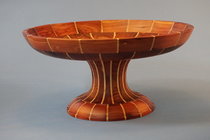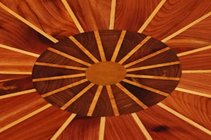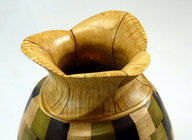A flat work friend just tuned me into this video and I think you folks will want to watch it as well. Without giving away the ending It's about end grain glue ups. I'll just say that I love it when dogma gets sent to the dog house.
View: https://www.youtube.com/watch?v=m7HxBa9WVis
-
It's time to cast your vote in the December 2025 Turning Challenge. (click here for details) -
Congratulations to Pat White for "Sicilian Mosaic" being selected as Turning of the Week for December 29, 2025 (click here for details) -
Welcome new registering member. Your username must be your real First and Last name (for example: John Doe). "Screen names" and "handles" are not allowed and your registration will be deleted if you don't use your real name. Also, do not use all caps nor all lower case.
You are using an out of date browser. It may not display this or other websites correctly.
You should upgrade or use an alternative browser.
You should upgrade or use an alternative browser.
End Grain Bonding
- Thread starter Mark Jundanian
- Start date
Great vid! When I would glue end grain to end grain, I would first coat the surfaces with glue and let it set a little while, then add some more and clamp it up. The joints never failed and I attributed that to my method, but it turns out I did not need to be so tricky!
Best, Spike
Best, Spike
Well, his methods are very thoughtful and methodical.
The results were interesting and certainly challenged the rule of thumb.
Things I still wonder about:
Glues have changed over the years. How much effect does that have on this long-lived myth?
My understanding of the primary reason side-to-end grain joints were weak was due to movement in the wood over time. I don't think his test methods addressed that aspect.
How does a glue joint age or fatigue over time relative to the wood strength?
The results were interesting and certainly challenged the rule of thumb.
Things I still wonder about:
Glues have changed over the years. How much effect does that have on this long-lived myth?
My understanding of the primary reason side-to-end grain joints were weak was due to movement in the wood over time. I don't think his test methods addressed that aspect.
How does a glue joint age or fatigue over time relative to the wood strength?
Brian Horais
In Memoriam
When I want to join end grain to cross grain with turnings, I use a technique that was shown to me a few years ago (I think it was Kurt Theobald who did this). I use a thin layer of crafting plywood between the end grain and cross grain sections. This allows for movement between the different grain patterns with changes in humidity, temperature, etc. Here's a closeup image of a turning I did using the plywood layer technique. The thin ring between the lower segments and upper vertical grain portion is the plywood ring.
Attachments
Thanks for posting this! Lot’s of history thinking the other way…but this appears sound. Sound enough to nudge me off of my prior beliefs, but I probably won’t be a ‘true believer’ until I start to see this replicated. In the meantime I’m not so sure of the old wisdom though, and will probably start experimenting with what I previously believed was heresy.
A couple thoughts I’d like to hear more on (besides replicating the results):
* end to side over time, still a little concerned his results may not last with continuous expansion/contraction stress (end to end probably holds up over time due to lack of this stress?).
* clamping pressure influence
Thanks again for sharing!
A couple thoughts I’d like to hear more on (besides replicating the results):
* end to side over time, still a little concerned his results may not last with continuous expansion/contraction stress (end to end probably holds up over time due to lack of this stress?).
* clamping pressure influence
Thanks again for sharing!
It is interesting to see the results of the test, but it doesn't really change anything. You can make your own test by making segmented rings then leave them unlaminated during a seasonal change and as the width of the segments change one or more joints will crack and the only thing that will prevent it is to laminate before the change.
Don,
What do you expect would happen if you laminated a vertical ring in amongst the typical horizontal segmenting? Meaning from the side you’d see the typical horizontal grain on most but a vertical grained ring included. Would you expect it to hold well over time?
Thx
What do you expect would happen if you laminated a vertical ring in amongst the typical horizontal segmenting? Meaning from the side you’d see the typical horizontal grain on most but a vertical grained ring included. Would you expect it to hold well over time?
Thx
I am going to have to dig around my shop. Somewhere i have a handful of mis measured rings floating around my shop that i made over the years thinking i would find a project for them. The last time i saw them the joints were still solid.It is interesting to see the results of the test, but it doesn't really change anything. You can make your own test by making segmented rings then leave them unlaminated during a seasonal change and as the width of the segments change one or more joints will crack and the only thing that will prevent it is to laminate before the change.
It is hard to say, but I have done something similar to that where a conventional horizontal ring was laminated to a pie crust layer and that seams to be holding together. The bowl / platter (juniper with poplar accents) is made up of one horizontal ring and a pie crust layer so the rim shows side grain and the pie crust shows end grain. The pedestal column is stave segmented and the base is horizontal so that means that there are 4 places that meet horizontal to vertical grain.Don,
What do you expect would happen if you laminated a vertical ring in amongst the typical horizontal segmenting? Meaning from the side you’d see the typical horizontal grain on most but a vertical grained ring included. Would you expect it to hold well over time?
Thx

Hmm, food for thought! I will be pondering this for a while....
robo hippy
robo hippy
Beautiful piece Don,
How did you do the center (top down view), curious the method and how the glue joints have held up (trust they have).
john lucas
AAW Forum Expert
.most interesting. I did an end.grain to end grain test years ago. I did not to side grain topside grain. I cut 6" long pieces 3/4" square. I tried several.species and 3 samples.of each. Been too Many years to remember all the details. I suspected end brain to end grain was weak and wanted to test glues. I clamped the pieces in a vice and then slid a 21/2lb weight out away from the joint. CA glue was rediculously weak. Gorilla glue and PVA were. Ot much better and broke before the weight got far out the 6" piece of wood. PVA glue with a sized joint held far better. I applied the glue let it soak into the end grain for 20 seconds and then applied more glue and clamped them together. Epoxy was by far the best. Had to clamp a 2 foot.dowel.to the 6" piece and slide the weight out that to get it to break. I did not try side grai to side grain because I had never had a side grain joint fail. I did the test because I was doing more segmented work and joints always failed in and end grain to end grain glue up.
The pie crust top and the base segment ring both had the center trued up with a tapered hole, then matching male tapers were cut on the staved column then with the female side mounted in the lathe and the column held in another chuck, glue was applied and then using the tailstock for alignment and pressure they were forced together. The tapered joint compresses the glue just like clamping two boards edge to edge rather scraping it off and if you get the tapers to match you will have a flawless round joint. The joints held up until it sold in a gallery in Bemidji, MN last Christmas so I don't know how it held up since then.Beautiful piece Don,
How did you do the center (top down view), curious the method and how the glue joints have held up (trust they have).

Roger Wiegand
Beta Tester
Quoting from myself in another forum...
One of the things that I learned working as a scientist is that when the data from your experiment contradict what you see happening in the real world, 99.9% of the time you have a problem with your experiment.
Having repaired perhaps 100 mitered picture frames over the decades where 100% of them had failed at the near end-grain miter joint while having only seen long grain joints fail in situations where the glue was seriously degraded by extreme age or by flood damage, I have to say I'm skeptical. I'm not a material science guy, so I'm not going to critique the testing methodology, but the outcome reeks of an artifact of the specific methodology employed.
I for one am not about to glue two 2x10's together end to end and then stand on the piece as planking on a scaffold.
One of the things that I learned working as a scientist is that when the data from your experiment contradict what you see happening in the real world, 99.9% of the time you have a problem with your experiment.
Having repaired perhaps 100 mitered picture frames over the decades where 100% of them had failed at the near end-grain miter joint while having only seen long grain joints fail in situations where the glue was seriously degraded by extreme age or by flood damage, I have to say I'm skeptical. I'm not a material science guy, so I'm not going to critique the testing methodology, but the outcome reeks of an artifact of the specific methodology employed.
I for one am not about to glue two 2x10's together end to end and then stand on the piece as planking on a scaffold.
Russ Braun
TOTW Team
It’s an interesting video; of course it doesn’t address the “wood movement” issue. Regarding the issue it addressed, the findings were interesting!
Pretty sure you wouldn’t stand on a platform supported only by an area of 1 5/8” x 9 5/8” of side grain glued either. The experimental evidence is intriguing. Makes me wonder if I’d stand on a platform supported by multiple feet of end grain glued? Not at any heightI for one am not about to glue two 2x10's together end to end and then stand on the piece as planking on a scaffold.
Picture frame example brings expansion into play (side grain to end grain over time and stresses) as well as highlighting tensile failure over time; both this experiment didn’t address well so I too don’t expect some things to hold up as well to further study. Still, this data is informing my understanding…
Last edited:
I'm straying here, but I know people worry about wood threads swelling or distorting. They will use brass or PVC fittings instead. Does that solve long term failure? Glue joint failure or epoxy joint holding causing wood failure? I have glued miss matched grain finials to hollow forms. Could this be trouble? I don't sell anything, but even if l give someone an item, failure would reflect on me. If that happened at home, that would be an opportunity to turn a better replacement.
The problem with this experiment is simply that it didn't address wood movement or compared the breaking strength of an end grain joint to a similar sized board without an endgrain splice.One of the things that I learned working as a scientist is that when the data from your experiment contradict what you see happening in the real world, 99.9% of the time you have a problem with your experiment.
Nothing has suddenly changed in the world of joinery for me. Except perhaps for my understanding of why things are the way we have all observed them to be.
The point that the research seems to make is that glue is not in fact stronger than wood. Glue is stronger than lignin and wood fibers are stronger than glue. Good joinery takes advantage of this fact by having wood fiber cross the joint.
In the scaffold example, I would not trust a 2x10 beam that was end glued either, but neither would I trust a continuous beam whose grain ran perpendicularly. A lap joint is stronger in this application because wood fibers cross the joint. But if I were making a lap joint maybe it would be worthwhile to put glue on the end grain as well as the long grain. You could make up an end glued beam that was strong enough, but it would need a huge cross section, and nobody is going to design a beam that uses that much wood. Wood fibers aren't just stronger than glue, they are a lot stronger.
A simple 45 degree miter will fail due to wood movement. If the wood swells or shrinks it changes the miter angle.
The point that the research seems to make is that glue is not in fact stronger than wood. Glue is stronger than lignin and wood fibers are stronger than glue. Good joinery takes advantage of this fact by having wood fiber cross the joint.
In the scaffold example, I would not trust a 2x10 beam that was end glued either, but neither would I trust a continuous beam whose grain ran perpendicularly. A lap joint is stronger in this application because wood fibers cross the joint. But if I were making a lap joint maybe it would be worthwhile to put glue on the end grain as well as the long grain. You could make up an end glued beam that was strong enough, but it would need a huge cross section, and nobody is going to design a beam that uses that much wood. Wood fibers aren't just stronger than glue, they are a lot stronger.
A simple 45 degree miter will fail due to wood movement. If the wood swells or shrinks it changes the miter angle.
Exactly and no glue is going to prevent that failure. The same problem will happen with segmented rings left on cross laminated.A simple 45 degree miter will fail due to wood movement. If the wood swells or shrinks it changes the miter angle.
You will notice that the only joint failure in the video was end to end all other configurations the wood itself failed. I was taught that a proper glue joint is stronger than the wood. This experiment does nothing to grange that belief.
all the failures were ductile failures except the end to end joint which was a brittle failure.
all the failures were ductile failures except the end to end joint which was a brittle failure.
I would be interested to know what the result would be with a scarf joint.

